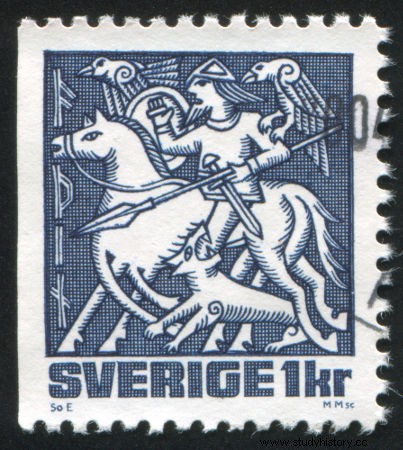
The peoples Vikings , who inhabited Scandinavia (now Norway, Sweden and Finland), in Northern Europe, had pagan religious beliefs , that is, non-Christians. The religious myths of these peoples are known today as Norse Mythology.
The Vikings were not extremely religious, the worship of the gods being carried out in times specific or on individual occasions, that is, when a person sought divine favor. An example of a Norse religious festival was the Jól (aka Yule ), which was held in winter and which was later appropriated by Christians and transformed into the celebration of the birth of Christ, Christmas . Another example of a religious festival is the Álfablót, which is seen according to the original sources as a festival of healing or celebration of the ancestors. On the other hand, the individual cult was related to requests to the gods and usually presented small sacrifices or small magic rituals.
Although they did not have a class of priests dedicated to religion, this function, especially in rituals and festivals, was performed by kings or nobles in sacred spaces or temples built for religious purposes, like the Temple of Uppsala, in Sweden. Vikings believed in mythical beings such as elves (Alfar) and dwarves (Dvergar), in addition to giants (Jötunn) and dragons . An important mythical being in the Viking religion was the Nornas, who were divine beings who ruled the destiny of men. The Norse view of the universe was centered on Yggdrasil , an ash tree that connected the nine existing worlds.
They had as their main god Odin , considered the most powerful god in Norse religion and called the “father of the gods”. According to Johnni Langer:
“Odin was a frightening, furious, violent, cruel, cynical, deceiving deity, but at the same time he was also an inspiration for poetry and magic. It was he who presided over the battles, and from his throne (Hlidskjálf ) observed everything that happened in the universe. He owned two crows, Huginn (thought) and Munnin (memory), which reported on the events of the world […]. Odin rode an eight-legged horse (Sleipnir ) and wielded a magic spear (Gungnir ). In the final battle (Ragnarök ) was devoured by the monstrous wolf Fenrir”|1| .
Other important gods were Thor, Freyja, Balder, Týr, Loki, etc. The end of the world for the Norse would happen in the so-called Twilight of the Gods (Ragnarök) , in which the gods would be destroyed, as well as part of the universe, after a final battle. However, recent studies defend the influence of Christianity on Ragnarök, and others point out that the myth of the end of the universe had little influence on Viking religiosity |2| . The Vikings were gradually being Christianized from the 10th century onwards, with traditional religiosity coming from paganism being restricted to the private environment and present in Nordic folklore.
|1| LANGER, Johnni. Gods, Monsters and Heroes:Essays on Viking Mythology and Religion. Brasília:Editora Universidade de Brasília, 2009, p. 184.
|2| LANGER, Johnni. Ragnarok. In.:LANGER, Johnni (eds.) Dictionary of Norse Mythology:Symbols, Myths and Rites. São Paulo:Hydra, 2015, p. 391-394.
* Image credit:rook76 / Shutterstock.com
by Daniel Neves
Graduate in History
